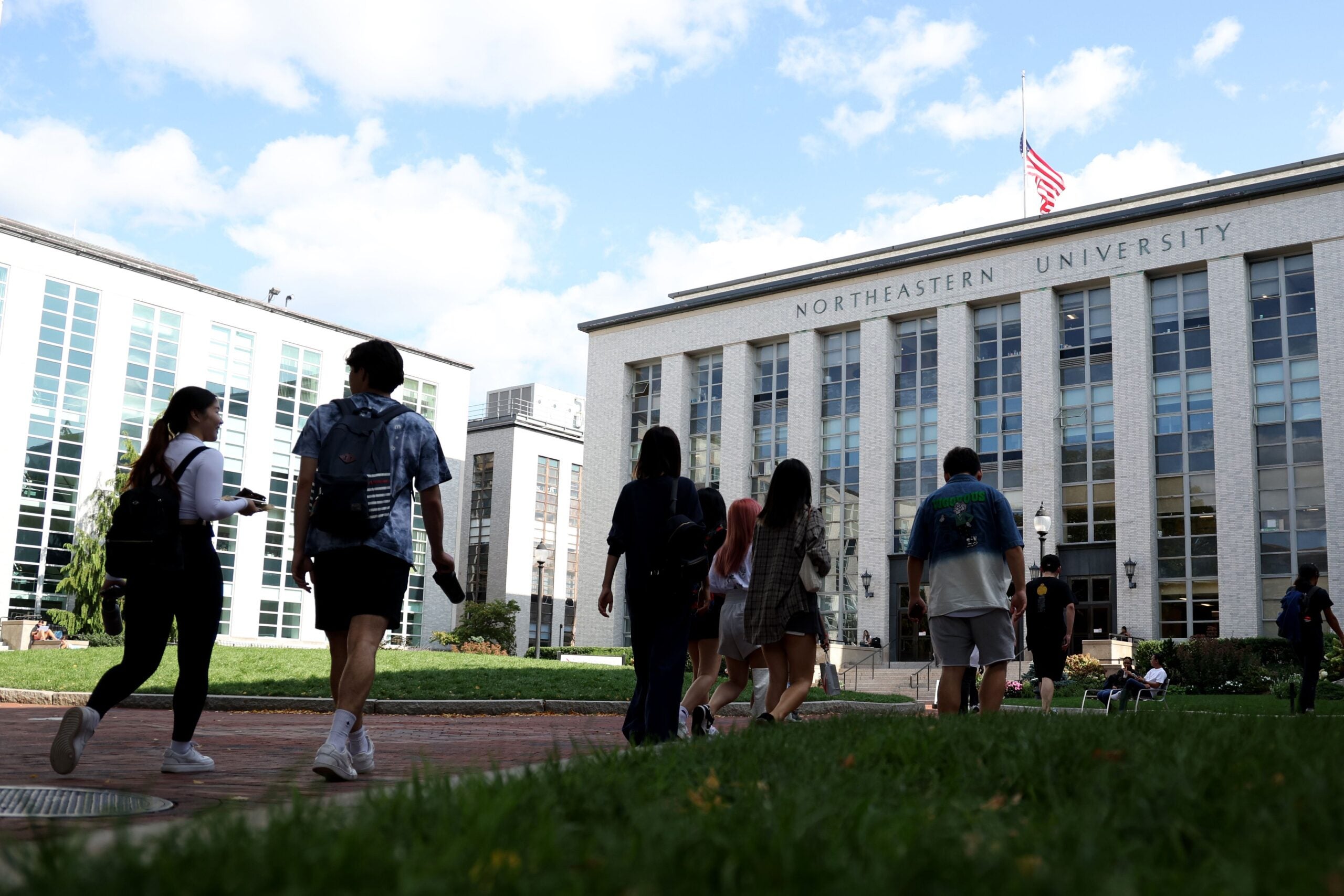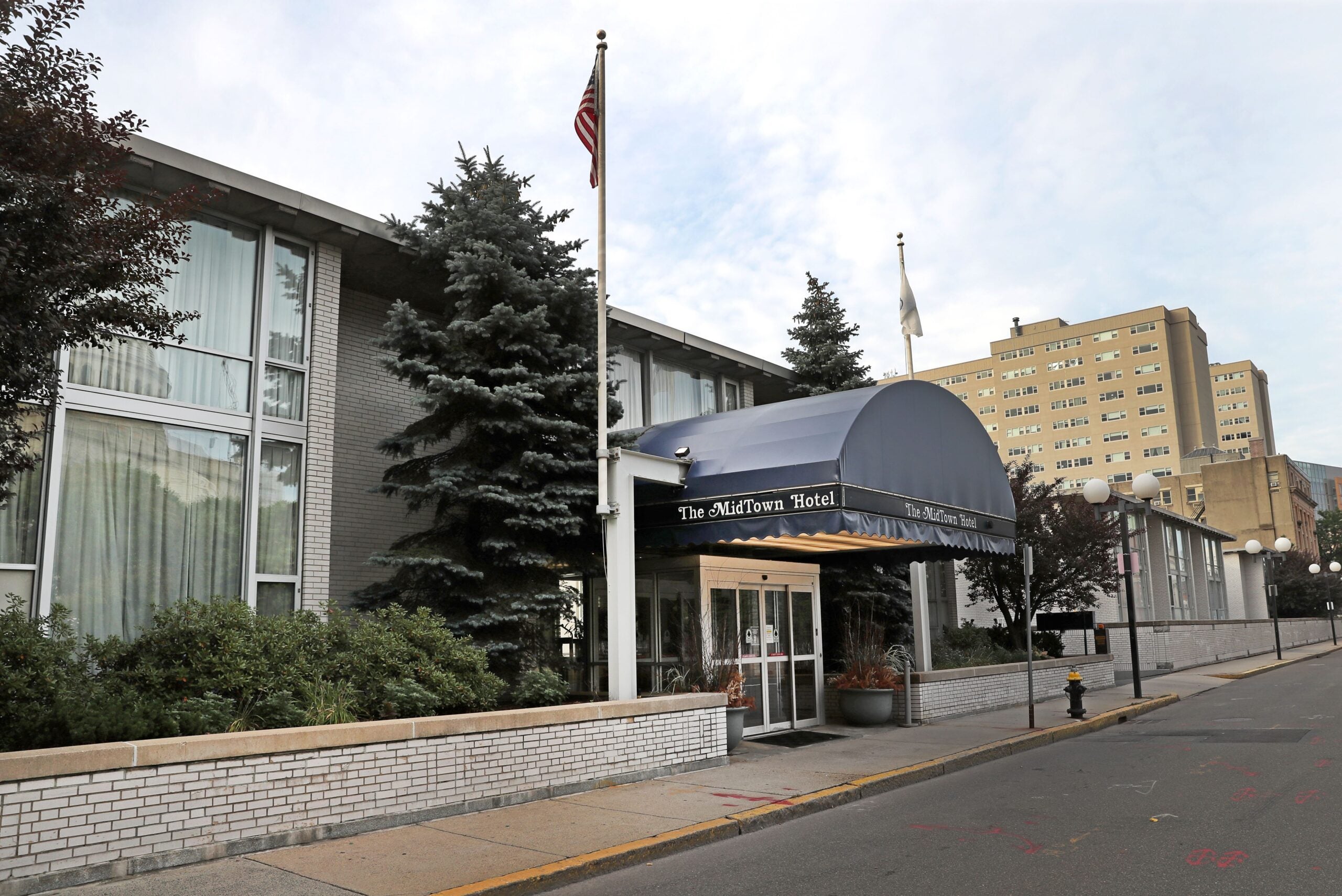Local News
In January, the Boston Planning and Development Agency approved Northeastern University’s request to permanently convert the south tower of the Sheraton hotel into student housing.

Cramped dorms are a quintessential part of being a college student. The inconvenience comes with the benefit of living within walking distance of friends, classes, and pretty much every other aspect of a college student’s day-to-day life. But the age-old trope of students living in dorms is disappearing for some attending schools in Boston.
To accommodate more students and the increased demand for housing, some colleges in Boston have turned to a creative solution in a city that’s facing a housing crisis: hotels.�
Colleges across the country used hotels as housing to help with social distancing during the COVID-19 pandemic. Four years later, schools in Boston — most notably Northeastern — have continued to rent or even buy space in hotels for student use amid a shortage of housing.
“I honestly loved my time at the Sheraton. The big room was so nice,” said Mars Poper, a second-year Northeastern student who lived in the former hotel, adjacent to the Prudential Center, in 2023 and 2024. “But also, would I rather have a smaller space but live closer to campus? Maybe.”
In January, members of the Boston Planning and Development Agency (BPDA) unanimously approved an application by Northeastern to allow the school to convert the south tower of the Sheraton Hotel into permanent undergraduate housing for approximately 856 students. The building is undergoing several charges to more closely resemble a dorm, including the creation of laundry, fitness, and study areas as well as a “dedicated outdoor space.”
Though unconventional, students say living at the Sheraton, now known as 60 Belvidere St., is not too different from living in typical off-campus housing, though the students living at the hotel are often first- and second-year students who had expected to live on campus.
Mix of forces at play with conversion of hotels to dorms

Colleges across Greater Boston turned to hotels to house students during the era of social-distancing protocols, part of a national trend.
Suffolk University rented out several hotels, including the Boxer and Wyndham, for people to live in during the pandemic. The year before the onset of COVID-19, the school purchased the historic Ames Building, converted it into a permanent residence hall, and opened it to students in the fall of 2020.�
Emerson College housed students on almost a dozen floors at the W hotel in 2020, and though the New England Conservatory of Music considered renting the Revolutionary Hotel for space, it pulled out after “students were able to arrange their own accommodations,” a college official told Boston.com.�
The scope of Northeastern’s hotel usage exceeded other nearby colleges. During the pandemic, the school used the Midtown, Westin, and Sheraton hotels to accommodate students, and continues to fully lease out the Midtown Hotel in addition to the south tower of the Sheraton. The Sheraton Boston Hotel is the largest hotel in Boston, with 1,220 rooms and suites. Northeastern permanently leases 428 of those rooms.
The use of the hotel as student housing helps relieve market pressure on Boston’s already-difficult housing market, according to BPDA documents.�
“In support of the Housing Boston 2030 initiative, the conversion of underutilized hotel space into an undergraduate dorm supports the goal of increasing new off-campus student dormitory housing to relieve market pressure on Boston’s housing market,” a January update about the project from the BPDA reads.�
The project garnered a mix of support and objection from local residents. During a public comment period in October, one resident wrote that students living in non-university housing can “put upward pressure on already skyrocketing rental prices.”
“As universities like Northeastern open their doors to more students, the university has a responsibility to develop more housing to meet student needs,” the resident wrote. “This proposal is a step in the right direction.”
Others said the hotel’s conversion to student housing would negatively impact the city or otherwise provide no upsides for the community.�
“Simply put, we don’t see one single benefit to our neighborhood, the city of Boston, or local taxpayers for this conversion to occur,” one person wrote in opposition to the plan. “For the loss of tourists to local businesses, the negative impact to the Hynes Convention Center and significant loss of millions of dollars annually in local and state tax revenue in one of the most desirable areas in the city, what would our neighborhood get in return? A new dorm that includes its own insulated dining facility and students who will simply commute to [and] from Northeastern University each day.”
For students, the cost of living at 60 Belvidere St. is roughly comparable with living on Northeastern’s campus. Students residing there in the 2022-2023 academic year could expect to pay $5,610 per semester for an “enhanced” double bedroom suite, which includes a bathroom but no kitchen. A standard double bedroom suite elsewhere on campus adds up to $5,125.�
Besides taking over already-existing buildings, Northeastern has plans to build or create more student housing on their campuses. The BPDA recently approved Northeastern’s request to construct a residence hall at 840 Columbus Ave. The dorm would hold up to 1,370 beds, according to BPDA documents.�
Northeastern has added three residence halls — amounting to 3,655 new beds — over the past 15 years on its Boston campus, a spokesperson for the school said. In total, there are 12,000 beds available on the Boston campus in addition to the spots available at 60 Belvidere St.�
A spokesperson for the school declined to provide enrollment numbers for the Boston campus, but said study abroad programs, alternate undergraduate campuses, and out-of-state co-ops all factor into how many students live on campus each semester.�
Student experiences at Northeastern hotels vary

Northeastern has housed students at 60 Belvidere St. since fall 2021 and at the Midtown since 2018, according to the university. Now, most of the university’s students housed in hotels are coming back from the school’s first-year study abroad programs: NUi.n. and Global Scholars.�
Ella Warner, a first-year student in the NUi.n. program, which allows students to study abroad their first semester before coming to Boston, said she initially had concerns about integrating into campus while living at a hotel.�
“When I first decided to go to Northeastern, I was hesitant about the community aspect I was going to anyway,” said Warner, who lived at 60 Belvidere St. in the spring semester. “And then when I found out I was placed in the Sheraton, I had the same worry.”
Elli Einset, a first-year student who lived in the Midtown for the spring semester and also participated in N.U.in, had similar concerns when she found out she would be living in a hotel.�
“When I first found out I got Midtown, I was really disappointed because everyone was telling me how bad it was, and I didn’t know anything about housing on campus,” Einset said.�
But both students said their worries soon subsided. �
“I was really surprised to see that while it was obviously not the best, it was a lot better than I was expecting,” Einset said.
Warner said her room’s spaciousness allowed her friends to come over and the school did an “OK job” of holding social events for residents. This seemed “luxurious” compared with the situation for other students.
“The only two locations [coming back from N.U.in] that I know people were placed in were International Village and the Sheraton,” Warner said. “And they both have their pros and cons because everyone in International Village got placed in forced doubles. And those were my friends that would take the 20 minute walk to the Sheraton just to hang out because we had so much space.”
Students said “forced doubles” are rooms that are originally made to house one person but now house two. The university did not answer questions from Boston.com about whether extra students are placed in rooms originally meant to house fewer students.
The hotel’s proximity to landmarks like the Prudential Center, Newbury Street, and Boylston Street were also a plus for Warner.�
Patrick O’Neill, a second-year student, said the hotel has improved since first being occupied by students. O’Neill has lived in the building since the spring of 2023, and decided to return for the previous academic year because it was “the best” out of several housing options on campus, pointing to a larger space and air conditioning.�
The school installed a food market in the former lobby of the hotel in the spring semester. Before that, accessing dining halls from the dorm could be difficult, students said.
The Midtown, though, is a different story, students said. Since it is leased by Northeastern only through the summer of 2025, according to the hotel’s website, the school hasn’t made the same renovations it has for the former Sheraton.�
Though resident assistants hold events at the Midtown, students told Boston.com there’s a lack of common space and participation in activities.�
“There wasn’t really a common area,” Einset said. “And no one’s in the lobby at Midtown. I felt disconnected [from campus] because I have to walk all the way back.”
First-year student Raymond Hackett, who is living in the Midtown for the summer, said that while he has to plan his time differently to account for his commute to and from campus, he decided to live in the hotel because it has air conditioning — not something every on-campus dorm has.�
“For me, the trade off was worth it for 10 or so extra minutes having to walk,” Hackett said.�
Unlike 60 Belvidere St., the Midtown doesn’t have in-house food options or a gym.�
“I feel like I definitely skipped meals because I didn’t feel like walking all that way,” Einset said.�
For most students living at the hotels, access to food seemed to be the biggest downside to their unusual arrangement. Neither the Midtown or 60 Belvidere St. dorms have kitchens.
“Maybe I would rather have a smaller space but live closer to campus,” Poper said. “If I could have a kitchen, everything would be fine.”
Newsletter Signup
Stay up to date on all the latest news from Boston.com
#Bostonarea #colleges #turning #hotels #house #students
